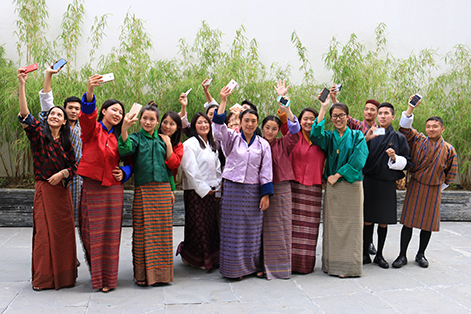Two reports: Western Sydney University and UNICEF unite to help minimise harm for children in the online digital world
A new global report released by UNICEF Australia investigates the relationship, impacts, opportunities and threats of the internet and digital technology on children. It calls on public and private sectors to do more to protect children online and harness the opportunities for their development. The report makes 29 recommendations under six priority actions that will help benefit disadvantaged children in all countries and minimise harm to the most vulnerable children everywhere.
 Image copyright UNICEF Bhutan/2017/Sherpa
Image copyright UNICEF Bhutan/2017/Sherpa
In Australia (opens in a new window)we already know that 82 per cent of Australian teenagers are online, 22 per cent were under eight the first time they did so, while 8 per cent of children and 19 per cent of teens experience cyberbullying and are exposed to inappropriate content on the internet.
“With children making up 1 in 3 internet users worldwide, and 71 per cent of young people online, The State of the World’s Children 2017: Children in a Digital World (opens in a new window)discusses how digital access can be a game changer for children or yet another dividing line,” said UNICEF Australia Director, Tony Stuart.
The report argues that governments and the private sector have not kept up with the pace of change, exposing children to new risks and harms and leaving millions of the most disadvantaged children behind.
“The internet was designed for adults, but it is increasingly used by children and young people – and digital technology increasingly affects their lives and futures,” Mr Stuart said. “But while the internet has the ability to significantly benefit children, we need to realise it also has the capacity to enable harm to them.”
Children in a Digital World includes the insights of almost 500 children aged 10-18 from 26 countries on how and why they use digital technology, as well as their aspirations for the digital future.
It examines the digital opportunities – from equality to education - as well as the divides that prevent millions of children from accessing through the internet new opportunities to learn and, someday to participate in the digital economy, helping to break intergenerational cycles of poverty. At the same time, it explores the darker side of the digital world, from cyber-bullying to online sexual abuse to dark web transactions that can make it easier to conceal trafficking and other illegal activities that harm children.
The research team from Western Sydney University included the views and experiences of children and young people on these issues, supporting Children in the Digital World with a comprehensive companion report exclusively in children’s voices, Young and Online: Children’s Perspectives on Life in the Digital Age (opens in a new window).
Principal Researcher from the University’s Institute for Culture and Society, Amanda Third said, “The views of children represented in these reports paint a picture of the very diverse ways that children are using and making sense of digital media in different parts of the world. Overall, the reports demonstrate that it is vital that the research, policy and practice community continue to work ever more closely with children, valuing their insights and ensuring they play a key role in maximising the opportunities of the digital age.”
The recommendations across the six priority action points reflect the core principle that should guide policymaking and practical action in the digital sphere:
1. Provide all children with affordable access to high-quality online resources.
2. Protect children from harm online – including abuse, exploitation, trafficking, cyberbullying and exposure to unsuitable materials.
3. Safeguard children’s privacy and identities online.
4. Teach digital literacy to keep children informed, engaged and safe online.
5. Leverage the power of the private sector to advance ethical standards and practices that protect and benefit children online.
6. Put children at the centre of digital policy.
“As the report makes clear, there is no shortage of international instruments, guidelines, agreements and principles that deal with issues such as internet freedom, openness, net neutrality, accessibility and respect for human rights,” Mr Stuart said. “We don’t need more guidelines, so much as agreed principles and priority actions that recognise the responsibility we share to protect children from the perils of the digital world and to help every child benefit from the promise of connectivity.”
This international research project was jointly executed by RErights.org, the Institute for Culture and Society, UNICEF New York and 26 UNICEF Country Offices and National Committees.
Resources
- The main report, The State of the World’s Children 2017: Children in a Digital World (opens in a new window) and summary report (opens in a new window)
- Fact Sheet: Australian Perspectives on Key Messages (opens in a new window)
- The companion report, Young and Online: Children’s Perspectives on Life in the Digital Age (opens in a new window)
Interviews can be arranged with: Amanda Third, Principle Research Fellow, Western Sydney University Institute for Culture and Society.
Posted: 18 December 2017.
Media release by UNICEF Australia (opens in a new window)




